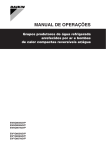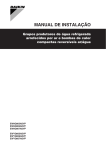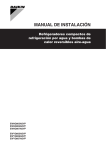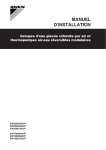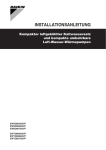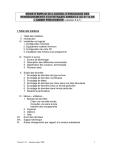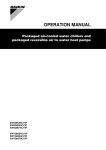Download Daikin EWYQ007ADVP Installation manual
Transcript
OPERATION MANUAL Packaged air-cooled water chillers and packaged reversible air to water heat pumps EWAQ005ADVP EWAQ006ADVP EWAQ007ADVP EWYQ005ADVP EWYQ006ADVP EWYQ007ADVP EWAQ005ADVP EWAQ006ADVP EWAQ007ADVP EWYQ005ADVP EWYQ006ADVP EWYQ007ADVP CONTENTS Packaged air-cooled water chillers and packaged reversible air to water heat pumps Page Contents .................................................................................... 1 1. Introduction................................................................................ 1 2. Operating the digital controller................................................... 1 2.1. 2.2. 2.3. 2.4. 2.5. 2.6. Features and functions................................................................... 1 Name and function of buttons and icons........................................ 2 Setting up the controller ................................................................. 3 Description of the operation modes ............................................... 3 Controller operations...................................................................... 3 Programming and consulting the schedule timer ........................... 5 1.0.3. Operation manual Main components The main components of the system are: ■ The digital controller which allows the complete configuration and follow-up of the system. ■ The manometer which indicates the pressure in the closed water circuit. ■ The safety valve which prevents the pressure in the closed water circuit from exceeding 3 bar. 3. Maintenance .............................................................................. 8 3.1. 3.2. 3.3. Important information regarding the refrigerant used .................... 8 Maintenance activities.................................................................... 8 Standstill ........................................................................................ 8 4. Troubleshooting ......................................................................... 8 5. Disposal requirements............................................................... 8 2. OPERATING Operating the unit comes down to operating the digital controller. Never let the digital controller get wet. This may cause an electric shock or fire. Never press the buttons of the digital controller with a hard, pointed object. This may damage the digital controller. READ THIS MANUAL ATTENTIVELY BEFORE STARTING UP THE UNIT. DO NOT THROW IT AWAY. KEEP IT IN YOUR FILES FOR FUTURE REFERENCE. Before operating the unit, make sure the installation has been carried out correctly by a professional Daikin dealer. If you feel unsure about operation, contact your Daikin Dealer for advice and information. The original instructions are written in English. All other languages are translations of the original instructions. This appliance is not intended for use by persons, including children, with reduced physical, sensory or mental capabilities, or lack of experience and knowledge, unless they have been given supervision or instruction concerning use of the appliance by a person responsible for their safety. Children should be supervised to ensure that they do not play with the appliance. THE DIGITAL CONTROLLER Never service the digital controller yourself, ask a qualified service person to do this. 2.1. Features and functions The digital controller is a state of the art controller that offers full control over your installation. It can control a cooling/heating and a cooling only installation. Both installations are available in multiple versions which vary in capacity. NOTE 2.1.1. Some functions described in this manual may not be available or should not be available. Ask your installer or your local Daikin dealer for more information on permission levels. Basic controller functions The basic controller functions are: 1. INTRODUCTION ■ Turning the unit ON/OFF. ■ Operation mode change-over: - heating (refer to "2.4.1. Heating operation (h)" on page 3), - cooling (refer to "2.4.2. Cooling operation (c)" on page 3), - quiet mode (refer to "2.4.3. Quiet mode operation (s)" on page 3). ■ Temperature set point adjustment (refer to "2.5. Controller operations" on page 3). Thank you for purchasing this Daikin inverter chiller. 1.0.1. This manual This manual describes how to start up and switch off the unit, set parameters and configure the schedule timer by means of the controller, maintain the unit and solve operational problems. For “Checks before initial start-up” and “Initial start-up” procedures refer to the “Installation manual” of this unit. 2.1.2. Clock function The clock functions are: 1.0.2. This unit This unit is designed for outdoor installation and used for both heating and cooling applications. The unit is designed to be combined with fan coil units or air handling units for air conditioning purposes. This chiller range consists of 2 main versions: a heat pump (EWYQ) version and a cooling only (EWAQ) version, available in 3 standard sizes (5 kW, 6 kW and 7 kW). Operation manual 1 ■ 24 hour real time clock. ■ Day of the week indicator. 2.1.3. Schedule timer function The schedule timer function allows the user to schedule the operation of the installation according to a daily or a weekly program. EWAQ+EWYQ005~007ADVP Packaged air-cooled water chillers and packaged reversible air to water heat pumps 4PW71885-1 – 10.2011 2.2. Name and function of buttons and icons 12 SETTING $ Not used. For installation purposes only. 8 5 6 22 15 16 3 2 1 13 NOT AVAILABLE n This icon is displayed whenever a function is not available in your configuration. n may also appear due to the restrictions of the user permission level set by the installer. 4 7 14 19 17 9 18 13 9 12 10 21 20 14 15 17 29 28 18 ON/OFF BUTTON o Pressing the ON/OFF button consecutively too many times may cause malfunction of the system (maximum 20 times per hour). 19 OPERATION LED 0 The icon is also displayed when the temperature set point is set in schedule timer programming mode. 20 OPERATION MODE ICONS hcs 5 21 In a cooling only installation, the h icon will never be displayed. 22 23 24 7 25 26 SCHEDULE TIMER ICON p 9 27 OFF ICON x The button is also used to program the controller. The function of the button depends on the actual status of the controller or on previous actions carried out by the operator. INSPECTION REQUIRED k and l If the controller is set in permission level 2 (refer to the installation manual), the schedule timer button will not be operational. These icons indicate that inspection is required on the installation. Consult your Daikin Dealer. 11 SET TEMPERATURE DISPLAY 9 The display shows the current set temperature of the installation. EWAQ+EWYQ005~007ADVP Packaged air-cooled water chillers and packaged reversible air to water heat pumps 4PW71885-1 – 10.2011 SCHEDULE TIMER BUTTON pr The main function of this multi-purpose button is to enable/ disable the schedule timer. This icon indicates that the OFF action is selected when programming the schedule timer. 10 PROGRAMMING BUTTON < This multi-purpose button is used to program the controller. The function of the button depends on the actual status of the controller or on previous actions carried out by the operator. ACTION ICONS q These icons indicate the programming actions for each day of the schedule timer. INSPECTION/TEST OPERATION BUTTON z This button is used for installation purposes only. Refer to the installation manual. This icon indicates that the schedule timer is enabled. 8 WEATHER DEPENDENT SET POINT BUTTON ba This button enables or disables the weather dependent set point function which is available in space heating operation only. The clock display shows the current time. When reading or programming the schedule timer, the clock display shows the action time. HEATING/COOLING BUTTON = This button allows manual switching between cooling or heating mode (provided the unit is not a “cooling only” unit). DAY OF THE WEEK INDICATOR 1234567 CLOCK DISPLAY 8 ERROR CODE : This code refers to the error code list and is for service purposes only. Refer to the service manual. When reading or programming the schedule timer, the indicator shows the set day. 6 FIELD SET CODE ; This code represents the code from the field set list. Refer to the installation manual. CENTRALIZED CONTROL e This indicator shows the current weekday. TEST OPERATION ICON t This icon indicates that the unit runs in test mode. Refer to the installation manual. These icons indicate the current operation mode(s): heating (h), cooling (c) or quiet mode (s). Quiet mode is a feature of the cooling or heating operation mode. When quiet mode is activated, the quiet mode icon and the heating or cooling mode icon will be displayed simultaneously. This icon indicates that the unit is in remote off mode, cooling mode or heating mode. This disables some functions of the remote controller. TEMPERATURE ICON b This icon is displayed together with the temperature set point, the water outlet temperature or the outdoor ambient temperature. The operation LED is lit during cooling or heating operation. The LED blinks if a malfunction occurs. When the LED is OFF, cooling or heating are inactive. 4 WEATHER DEPENDENT SET POINT ICON a This icon indicates that the controller will adapt the temperature set point automatically, based on the outdoor ambient temperature. The ON/OFF button starts or stops the controller. 3 OUTDOOR TEMPERATURE DISPLAY u When this icon is flashing, the outdoor ambient temperature is displayed. 25 2 PUMP ICON é This icon indicates that the circulation pump is active. 23 24 27 1 COMPRESSOR ICON ç This icon indicates that the compressor in the outdoor unit of the installation is active. 16 30 26 DEFROST MODE ICON d This icon indicates that the defrost mode is active. 28 TIME ADJUST BUTTON pi and pj These multi-purpose buttons are used to adjust the clock, to toggle between temperatures (water outlet temperature and outdoor ambient temperature) and in schedule timer programming mode. Operation manual 2 29 TEMPERATURE ADJUST BUTTONS bi and bj These multi-purpose buttons are used to adjust the current set point in normal operation mode or in schedule timer programming mode. In weather dependent set point mode the buttons are used to adjust the shift value. Finally, the buttons are also used to select the weekday while setting the clock. 30 QUIET MODE BUTTON s This button enables or disables quiet mode. 2.4. 2.4.1. Description of the operation modes h) Heating operation (h In this mode, heating will be activated as required by the temperature set point. The set point can be set manually (refer to "2.5.1. Manual operation" on page 3), weather dependent (refer to "2.5.3. Weather dependent operation (heat pump models only)" on page 4) or according to the defrost demand from the outdoor unit. d) Defrost (d NOTE 2.3. Buttons that are not described above are not used in this configuration. Pressing these buttons (w, wbj and wbi) has no influence on the operation. When these buttons are pressed, n will be displayed. Setting up the controller In heating operation, freezing of the outdoor heat exchanger may occur due to low outdoor temperature. If this risk occurs, the system goes into defrost operation. It reverses the cycle and takes heat from the indoor system to prevent freezing of the outdoor system. After a maximum of 10 minutes of defrost operation, the system returns to heating operation. NOTE Defrosting stops: After initial installation, the user can set the clock and day of the week. ■ when switching between cooling and heating, ■ The controller is equipped with a schedule timer that enables the user to schedule operations. Setting the clock and day of the week is required to be able to use the schedule timer. at a low outdoor temperature and a low temperature of the incoming water, ■ when the desired defrost temperature is reached, i.e. defrost stop temperature (contact your local Daikin dealer). 2.3.1. 1 Setting the clock Heating operation restarts automatically when the water temperature is above the defrost stop temperature. Hold down the pr button for 5 seconds. The clock read-out and the day of week indicator start flashing. 2 Use the pi and pj buttons to adjust the clock. Each time the pi or pj button is pressed, the time will increase/decrease by 1 minute. Keeping the pi or pj button pressed will increase/decrease the time by 10 minutes. 3 Use the bi or bj button to adjust the day of the week. Each time the bi or bj button is pressed the next or previous day is displayed. 4 Press the < button once to confirm the current set time and day of the week. NOTE 2.4.2. 2.3.2. The clock needs to be set manually. Adjust the setting when switching from summertime to wintertime and vice versa. Setting the schedule timer To set the schedule timer, refer to chapter2.6. "Programming and consulting the schedule timer" on page 5. c) Cooling operation (c In this mode, cooling will be activated as required by the temperature set point. NOTE If no button is pressed for 5 minutes, while the clock and day of the week read-out are still flashing, the clock and day of the week will return to their previous setting and the clock setting function will no longer be active. NOTE Heating operation is not possible if the installation is a "cooling only" installation. 2.4.3. ■ The cooling temperature set point can only be set manually (refer to "2.5.1. Manual operation" on page 3). ■ Switching between heating and cooling operation can only be done by pressing the = button (provided the unit is not a "cooling only" unit). s) Quiet mode operation (s Quiet mode operation means that the outdoor unit works at reduced capacity so that the noise produced by the outdoor unit drops. This implies that the indoor heating and cooling capacity will also drop. Beware of this when a certain level of heating is required indoors. 2.5. Controller operations 2.5.1. Manual operation In manual operation, the user manually controls the temperature settings of the installation. The last setting remains active until the user changes it or until the schedule timer does. As the controller can be used for a wide variety of installations, it is possible to select a function which is not available on your installation. In that case the message n will appear. Operation manual 3 EWAQ+EWYQ005~007ADVP Packaged air-cooled water chillers and packaged reversible air to water heat pumps 4PW71885-1 – 10.2011 c) and heating (h h) Selection and setting of cooling (c 2.5.3. Use the = button to select cooling (c) or heating (h). 1 Icon c or h appears on the display as well as the corresponding temperature set point. Use the bi and bj buttons to set the correct temperature. 2 • • Temperature range for heating: 25°C to 55°C Temperature range for cooling: 5°C to 20°C NOTE The installer may have limited the above mentioned default ranges at initial installation of the unit. In weather dependent operation (icon a is shown), the controller calculates the water temperature set point based on the outdoor temperature. However, the user can set a "shift value". This shift value is the temperature difference between the temperature set point calculated by the controller and the real set point. E.g. a positive shift value means that the real temperature set point will be higher than the calculated set point. Selecting weather dependent operation 1 s) Selecting quiet mode operation (s Icon s appears on the display. 2 Displaying temperature values The b icon and the outgoing water temperature are displayed. The icons l and = are flashing. Use the pi and pj buttons to display: 2 • The outdoor temperature (u icon is flashing). • The outgoing water temperature (h or c is flashing). If no button is pressed for 5 seconds, the controller leaves the display mode. 2.5.2. Use the bi and bj buttons to set the shift value. Range for the shift value: –5°C to +5°C. Push the ba button for 5 seconds. 1 Press the ba button to select weather dependent operation. Icon a appears on the display as well as the shift value. The shift value is not shown in case it is 0. Use the s button to activate quiet mode operation (s). 1 Weather dependent operation (heat pump models only) Remote ON/OFF and cooling/heating operation 2.5.4. Schedule timer operation In schedule timer operation, the installation is controlled by the schedule timer. The actions programmed in the schedule timer will be executed automatically. The schedule timer always follows the last command until a new command is given. This means that the user can temporarily overrule the last executed programmed command by manual operation (Refer to "2.5.1. Manual operation" on page 3). The schedule timer will regain control over the installation as soon as the next programmed command of the schedule timer occurs. The schedule timer is enabled (p icon displayed) or disabled (p icon not displayed), by pressing the pr button. Terminal block H C N 8 9 10 NOTE ■ Only use the pr button to enable or disable the schedule timer. The schedule timer overrules the o button. The o button only overrules the schedule timer until the next programmed action. ■ If the auto restart function is disabled, the schedule timer will not be activated when power returns to the unit after a power supply failure. Press the pr button to enable the schedule timer again. ■ When power returns after a power supply failure, the auto restart function reapplies the user interface settings at the time of the power supply failure. H C th Function Standard operation(*) sw H+th C+th sw Closed Closed Closed Remote OFF — — Open Remote cooling Open Closed Closed Remote heating Closed Open Closed Icon e Compressor operation Pump operation ON/OFF with Remote controller Change mode possible Quiet mode possible Auto function possible Change temperature possible the unit is controlled by the remote controller Power LED (*) Standard operation ON OFF YES YES YES YES YES YES YES Remote OFF(*) OFF ON NO NO NO NO YES YES(**) YES Remote cooling ON ON YES YES NO NO YES NO YES Remote heating ON ON YES YES NO NO YES YES YES Function (***) (****) It is therefor recommended to leave the auto restart function enabled. ■ The programmed schedule is time driven. Therefore, it is essential to set the clock and the day of the week correctly. Refer to "2.3.1. Setting the clock" on page 3. ■ Manually adjust the clock for summertime and wintertime. Refer to "2.3.1. Setting the clock" on page 3. ■ A power failure exceeding 1 hour will reset the clock and the day of the week. The schedule timer will continue operation, but with a disordered clock. Refer to "2.3.1. Setting the clock" on page 3 to adjust the clock and the day of the week. ■ The actions programmed in the schedule timer will not be lost after a power failure so that reprogramming the schedule timer is not required. To set up the SCHEDULE TIMER refer to chapter "2.6. Programming and consulting the schedule timer" on page 5. (*) the unit stops in last operation mode (cooling or heating) (**) only if last operation was heating (***) cooling mode is selected (****)heating mode is selected EWAQ+EWYQ005~007ADVP Packaged air-cooled water chillers and packaged reversible air to water heat pumps 4PW71885-1 – 10.2011 Operation manual 4 What can the schedule timer do? 2.6. The schedule timer allows the following programming of heating or cooling: switch on the desired mode at a scheduled time, in combination with a set point (automatically calculated or manually set). Five actions per weekday can be programmed, totalling 35 actions. 2.6.1. The programmed actions are not stored according to their timing but according to the time of programming. This means that the action that was programmed first gets action number 1, even though it is executed after other programmed action numbers. Programming and consulting the schedule timer Getting started Programming the schedule timer is flexible (you can add, remove or alter programmed actions whenever required) and straightforward (programming steps are limited to a minimum). However, before programming the schedule timer, remind: ■ Familiarise yourself with the icons and the buttons. You will need them when programming. Refer to "2.2. Name and function of buttons and icons" on page 2. ■ Fill out the form at the very end of this manual. This form can help you define the required actions for each day. Keep in mind that: - In the cooling/heating program, 5 actions can be programmed per day. The same actions are repeated on a weekly basis. - In the quiet mode program, 5 actions can be programmed. The same actions are repeated on a daily basis. ■ Take your time to enter all data accurately. ■ Try to program the actions in a chronological way: start with action 1 for the first action and end with the highest number for the last action. This is not a requirement but will simplify the interpretation of the program later. Example: imagine the actual time is 17:30 and actions are programmed at 13:00, 16:00 and 19:00. The "last" programmed command (16:00) overruled the "previous" programmed command (13:00) and will remain active until the "next" programmed command (19:00) occurs. ■ If 2 or more actions are programmed for the same day and at the same time, only the action with the highest action number will be executed. ■ You can always alter, add or remove the programmed actions later. So in order to know the actual setting, one should consult the last programmed command. It is clear that the "last" programmed command may date from the day before. Refer to "2.6.3. Consulting programmed actions" on page 7 for consulting the programmed actions. ■ When programming heating actions (time and setpoint), cooling actions are added automatically at the same time but with the predefined default cooling setpoint. Conversely, when programming cooling actions (time and setpoint), heating actions are added automatically at the same time but with the default heating setpoint. What can the schedule timer NOT do? The schedule timer can not change the operation mode from cooling to heating or vice versa when the actual operation mode has been selected manually (by using the = button). How to interpret the programmed actions To be able to understand the behaviour of your installation when the schedule timer is enabled, it is important to keep in mind that the "last" programmed command overruled the "preceding" programmed command and will remain active until the "next" programmed command occurs. NOTE During schedule timer operation, someone may have altered the actual settings manually (in other words, the "last" comand was overruled manually). The icon p, indicating the schedule timer operation, may still be displayed, giving the impression that the "last" command settings are still active. The "next" programmed command will overrule the altered settings and return to the original program. The setpoints of these automatically added actions can be adjusted by programming the corresponding mode. This means that after programming heating, you should also program the corresponding cooling setpoints and vice versa. Due to the fact that the schedule timer cannot switch between operation modes (cooling or heating) and the fact that each programmed action implies a cooling setpoint and a heating setpoint, the following situations may occur: ■ when the schedule timer is active and in heating mode, and cooling is selected manually (by means of the = button), the operation mode will from then on remain cooling and program actions will follow the corresponding cooling setpoints. Returning to heating mode needs to be carried out manually (by means of the = button). ■ when the schedule timer is active and in cooling mode, and heating is selected manually (by means of the = button), the operation mode will from then on remain heating and program actions will follow the corresponding heating setpoints. Returning to cooling mode needs to be carried out manually (by means of the = button). The above proves the importance of programming both cooling and heating setpoints for each action. If you do not program these setpoints, the predefined default values will be used. Operation manual 5 EWAQ+EWYQ005~007ADVP Packaged air-cooled water chillers and packaged reversible air to water heat pumps 4PW71885-1 – 10.2011 2.6.2. Programming Programming cooling or heating is carried out as follows. Programming cooling or heating NOTE Returning to previous steps in the programming procedure without saving modified settings is done by pressing the pr button. 1 Use the = button to select the operation mode (cooling or heating) you want to program. 2 Press the < button. The actual mode is blinking. 3 Use the pi and pj buttons to select the mode (current mode or quiet mode) you want to program. The selected mode is blinking. You can leave programming by pressing the pr button. To program quiet mode, refer to " Programming quiet mode" on page 7. 4 Press the < button to confirm the selected mode. The selected day is blinking. 5 Select the day you would like to consult or to program by means of the pi and pj buttons. The selected day is blinking. You can return to step 3 by pressing the pr button. 6 Press the < button to confirm the selected day. The first programmed action of the selected day appears. 7 Use the pi and pj buttons to consult the other programmed actions of that day. This is called the readout mode. Empty program actions (e.g. 4 and 5) are not displayed. You can return to step 5 by pressing the pr button. 5 sec 8 Press the < button for 5 seconds to enter the programming mode. You can return to step 7 by pressing the pr button. 9 Use the < button to select the action number you would like to program or to modify. 10 Use the ba button to select: - x: to switch both cooling or heating and the controller off. 9: set the temperature by means of the bi and bj buttons. a: to select automatic temperature calculation (only in heating mode). You can change the shift value by means of the bi and bj buttons. 11 Use the pi and pj buttons to set the correct action time. 12 Repeat steps 9 to 11 to program the other actions of the selected day. When all actions have been programmed, make sure that the display shows the highest action number you would like to save. SAVE NO SAVE 5 sec NOTE Programming cooling or heating are both done in the same way. At the start of the programming procedure cooling or heating operation is selected. After that, you have to return to the start of the programming procedure to program the other operation mode. 13 Press the < button for 5 seconds to store the programmed actions. Actions are stored only after $ is displayed for 1 second. If the < button is pressed when action number 3 is displayed, actions 1, 2 and 3 are stored but 4 and 5 are deleted. You automatically return to step 7. By pressing the pr button several times, you return to previous steps in this procedure and finally return to normal operation. As mentioned in "2.6.1. Getting started" on page 5, adjust both heating and cooling setpoints for each programmed action. Otherwise, default setpoints will be used. EWAQ+EWYQ005~007ADVP Packaged air-cooled water chillers and packaged reversible air to water heat pumps 4PW71885-1 – 10.2011 Operation manual 6 Programming quiet mode 10 Press the < button for 5 seconds to store the programmed actions. If the < button is pressed when action number 3 is displayed, actions 1, 2 and 3 are stored but 4 and 5 are deleted. You automatically return to step 4. By pressing the pr button several times, you return to previous steps in this procedure and finally return to normal operation. 2.6.3. Consulting programmed actions Consulting cooling or heating actions NOTE Consulting cooling or heating is done in the same way. At the start of the consulting procedure, cooling or heating operation is selected. After that, you have to return to the start of the consulting procedure to consult the other operation mode. Consulting cooling or heating is carried out as follows. 1 Press the < button. The actual mode is blinking. 2 Use the pi and pj buttons to select the mode (current mode or quiet mode) you want to consult. The selected mode is blinking. You can leave consultation by pressing the pr button. To consult quiet mode, refer to " Consulting quiet mode actions" on page 7. 5 sec 3 Press the < button to confirm the selected mode. The actual day is blinking. SAVE NO SAVE 4 Select the day you would like to consult by means of the pi and pj buttons. The selected day is blinking. 5 sec You can return to step 2 by pressing the pr button. 5 Programming quiet mode is carried out as follows. NOTE 1 Returning to previous steps in the programming procedure without saving modified settings is done by pressing the pr button. 2 The first programmed action of the selected day appears. 6 Use the pi and pj buttons to select the quiet mode. The selected mode is blinking. You can return to step 4 by pressing the pr button. Consulting quiet mode actions Consulting quiet mode is carried out as follows. 1 You can leave programming by pressing the pr button. 3 Press the < button to confirm the selected mode. Use the pi and pj buttons to consult the programmed actions. This is called the readout mode. Empty program actions (e.g. 4 and 5) are not displayed. You can return to step 2 by pressing the pr button. 5 Press the < button for 5 seconds to enter the programming mode. You can return to step 4 by pressing the pr button. 6 Use the < button to select the action number you would like to program or to modify. Press the < button. The actual mode is blinking. 2 The selected mode is blinking. 4 Use the pi and pj buttons to consult the other programmed actions of that day. This is called the readout mode. Empty program actions (e.g. 4 and 5) are not displayed. Press the < button. The actual mode is blinking. Press the < button to confirm the selected day. Use the pi and pj buttons to select the quiet mode. The selected mode is blinking. You can leave programming by pressing the pr button. 3 Press the < button to confirm the selected mode. The selected mode is blinking. 4 Use the pi and pj buttons to consult the programmed actions of that day. This is called the readout mode. Empty program actions (e.g. 4 and 5) are not displayed. You can return to step 2 by pressing the pr button. 7 Use the pi and pj buttons to set the correct action time. 2.7. 8 Use the ba button to select or deselect x as action. Programming the next day(s) 9 Repeat steps 6 to 8 to program the other actions of the selected mode. After confirming the programmed actions of a specific day (i.e. after pressing the < button for 5 seconds), press the pr button once. You can now select another day by using the pi and pj buttons and restart consulting and programming. When all actions have been programmed, make sure that the display shows the highest action number you would like to save. Tips and tricks Copying programmed actions to next day In heating/cooling program it is possible to copy all programmed actions of a specific day to the next day (e.g. copy all programmed actions from "1" to "2"). Operation manual 7 EWAQ+EWYQ005~007ADVP Packaged air-cooled water chillers and packaged reversible air to water heat pumps 4PW71885-1 – 10.2011 To copy programmed actions to the next day, proceed as follows: 1 Press the < button. 2 3 4 3.2. The actual mode is blinking. Use the pi and pj buttons to select the mode you want to program. In order to ensure optimal availability of the unit, a number of checks and inspections on the unit and the field wiring have to be carried out at regular intervals, preferably yearly. This maintenance should be carried out by your local Daikin technician. The selected mode is blinking. You can leave programming by pressing the pr button. Press the < button to confirm the selected mode. Besides keeping the remote controller clean by means of a soft damp cloth, no maintenance is required by the operator. The actual day is blinking. Select the day you would like to copy to the next day by means of the pi and pj buttons. 3.3. Switching off the power supply stops the automatic repetitive movement of the motor in order to prevent it from getting jammed. After 5 seconds the display will show the next day (e.g. "2" if "1" was selected first). This indicates that the day has been copied. You can return to step 2 by pressing the pr button. Deleting one or more programmed actions Deleting one or more programmed actions is done at the same time as storing the programmed actions. When all actions for one day have been programmed, make sure that the display shows the highest action number you would like to save. By pressing the < button for 5 seconds, you store all actions except those with a higher action number than the one that is displayed. E.g. when the < button is pressed when action number 3 is displayed, actions 1, 2 and 3 are stored but 4 and 5 are deleted. 4. ■ ■ Use the pi and pj buttons to select the mode you want to delete (current mode or quiet mode s). 3 One of the error codes appears Consult your local Daikin dealer. The actual mode is blinking. 2 No readings on the remote controller (blank display) Check if the mains power is still connected to your installation. Press the < button. 1 TROUBLESHOOTING The guidelines below, completed by the chapter "Troubleshooting" in the installatation manual supplied with the unit, might help to solve your problem. If you cannot solve the problem, consult your installer. ■ Deleting a mode Standstill During longer periods of standstill, e.g. during summer with a heating only application, it is very important NOT TO SWITCH OFF THE POWER SUPPLY towards the unit. The selected day is blinking. You can return to step 2 by pressing the pr button. Press the < and pr buttons simultaneously for 5 seconds. 5 Maintenance activities The schedule timer does work but the programmed actions are executed at the wrong time (e.g. 1 hour too late or too early) Check if the clock and the day of the week are set correctly, correct if necessary. ■ The selected mode is blinking. I cannot enable the schedule timer (the e icon is displayed) Press the < and ba button simultaneously for 5 seconds to delete the selected mode. The schedule timer cannot be enabled because another component with higher priority is in control. Deleting a day of the week (cooling or heating mode) 1 Use the = button to select the operation mode (cooling or heating) you want to delete. 2 Press the < button. The actual mode is blinking. Press the < button to confirm the selected mode. 3 5. DISPOSAL REQUIREMENTS Dismantling of the unit, treatment of the refrigerant, of oil and of other parts must be done in accordance with relevant local and national legislation. The actual day is blinking. Select the day you would like to delete by means of the pi and pj buttons. 4 Your product is marked with this symbol. This means that electrical and electronic products shall not be mixed with unsorted household waste. The selected day is blinking. Press the < and ba button simultaneously for 5 seconds to delete the selected day. 5 3. 3.1. MAINTENANCE Important information regarding the refrigerant used Do not try to dismantle the system yourself: the dismantling of the system, treatment of the refrigerant, of oil and other parts must be done by a qualified installer in accordance with relevant local and national legislation. Units must be treated at a specialized treatment facility for re-use, recycling and recovery. By ensuring this product is disposed off correctly, you will help to prevent potential negative consequences for the environment and human health. Please contact the installer or local authority for more information. This product contains fluorinated greenhouse gases covered by the Kyoto Protocol. Refrigerant type: R410A GWP(1) value: 1975 (1) GWP = global warming potential Periodical inspections for refrigerant leaks may be required depending on European or local legislation. Please contact your local dealer for more information. EWAQ+EWYQ005~007ADVP Packaged air-cooled water chillers and packaged reversible air to water heat pumps 4PW71885-1 – 10.2011 Operation manual 8 4PW71885-1 10.2011 Copyright 2011 Daikin












